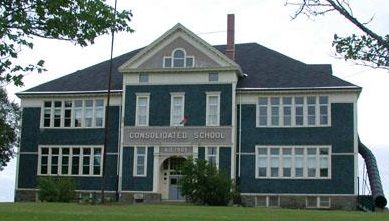GENERAL
Type / PurposeSchool
90 Water Street, Riverside-Albert, New Brunswick
Riverside Consolidated School is a blue three-story wood shingled building in the Queen Anne Revival style
Riverside Consolidated School, located at 90 Water Street in Riverside-Albert, was one of the longest-operating consolidated schools in Canada. In 1871, the Common Schools Act of New Brunswick was passed, banning private church-run schools, and replacing them with government-run 'common' schools. The goal of this was to reduce the educational inequality that had been negatively affecting rural areas. In 1904, the people of Riverside and Albert decided to construct a consolidated school between the towns to provide a better educational experience to the students in surrounding areas.
Thanks to the national advocation and funding initiatives of Montreal tobacco millionaire Sir William MacDonald, the idea of consolidating schools and providing manual training and household science in addition to traditional subject matter became popular in New Brunswick. This concept gained the attention of Abner Reid McClelan (1830–1917), a former Canadian Senator and Lieutenant-Governor of New Brunswick from 1896 to 1902. He donated $5000 to the construction of the Riverside school, covering a quarter of the total cost, provided that the school offered manual training, domestic science, and nature work. Each student was to be tasked with caring for an individual garden.
Once completed, the new school had eight classrooms, an office, a library, a laboratory, two lunchrooms, and two playrooms. About 240 students of all school ages were in attendance when the school opened in 1905. At the time, the facility was considered very modern thanks to its four furnaces, plumbing and ventilation systems, unique coursework, and the presence of a janitor who would maintain and heat the school. Now, the school serves students from kindergarten to fifth grade and is the oldest consolidated school operating in the province, with approximately 50 students attending every year.
Provincial Heritage Place (1997/05/27)
ARCHITECTURE
Date of Construction1904-1905
Exterior:
- Location in front of the Shepody River
- Large surrounding yard
- Varying stained wood shingles
- Regular wood-trimmed fenestration with tall and slim classroom windows
- Vertical band of white wood siding under roof
- Foundation of cut red sandstone, quarried in nearby Midway and New Ireland, encompassing the entire base of the building
- Separate entrances for male and female students, with the "Boys” entrance on the west side and the “Girls” entrance on the east
- Tuscan pilasters on the front and side entrances
- Dormer on all four sides, including a large front gable with a Palladian window
- Escape chute along side of building
Interior:
- Continued maintenance of front vestibule, the hallways and stairwells, classrooms, basement and auditorium spaces
- Stained turned wood columns with capitals in the basement, supporting the main floor
- Built-in wooden plant stands
- Use of medium stained hardwood in railings, banisters, mouldings and doors,
- Stamped metal tile ceilings throughout the building, with every room having a unique pattern
- Auditorium/gymnasium found on top floor within roof/dormer
- Collection of various pieces of academic memorabilia, including workbenches, tables, class photos, and learning materials such as textbooks and pamphlets
SOURCES AND DOCUMENTS
Links/Related Content Photos
Photograph by the Province of New Brunswick, 2005. Image taken from historicplaces.ca
Sources Contributors
Gabrielle Byrne


